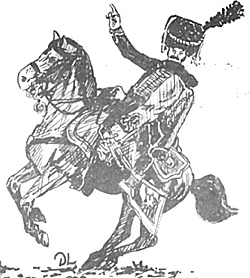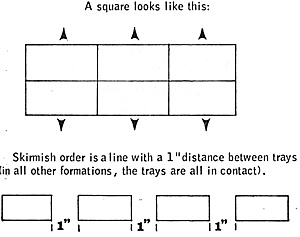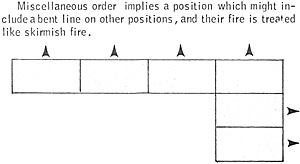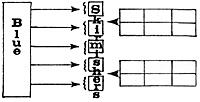 PREFACE
PREFACE
After three years of play-testing, this set of easy-to-use action-packed rules has been developed. It provides for simultaneous movement, an unusual feature. The last page contains an optional morale chart, so two different morale systems are presented. I hope you enjoy these rules, and at least find some ideas in them which are useful.
(Much thanks to Alex V. Brand, John Ross, Jay Hiserote, and Bill Fulcher.)
BASIC COMBAT RULES
BASICS OF INFANTRY
The standard infantry unit of this game shall be a battalion of 6 trays carrying 4 men apiece. Should a player wish to represent an overly large battalion, he may add trays as he wishes (with each figure representing 30 men for you scale/accuracy buffs). A tray shall be removed for each 4 casualties registered on the battalion.
 Formations
Formations
At all times, infantry shall be in either a line, a column, a square, skirmish order, or in miscellaneous order. A column is a formation 4 men wide, and six deep. Only the first two ranks may fire. A line is a 12x2 formation (both ranks can fire).
A square looks like this:
Skirmish order is a line with a 1" distance between trays (in all other formations, the trays are all in contact).
Miscellaneous order implies a position which might include a bent line or other positions, and their fire is treated like skirmish fire.
 It could look like this:
It could look like this:
BASICS OF CAVALRY
The basic cavalry unit is a 4-man unit called a squadron. Its only restriction to formation is that the men must be within an inch of each other.
BASICS OF ARTILLERY
The basic artillery unit is one gun with up to 12 artillerists. It shall fire either ball, shell, or grape. It needs no formation except all the artillerists; must be within 5" of the gun.
ORDERS and TURN SEQUENCE
Unlike other games, movement in this game is simultaneous. In order to facilitate this, at the beginning of each turn, a player shall, for infantry, indicate the direction and for how long (1/4 of its movement, all of it, etc.) it wishes to move, if it wishes to charge, or change formation (and what formation it will change to). For this, a set of standardized hieroglyphics is used.
- An arrow A advance in direction pointed to (the enemy is assumed to be at the top of the page).
A fraction 1/4 will show how far the unit desires to move (1/4 = 1/4 of the total allowable movement).
FLn - means the unit desires to form a line (this takes one turn).
FCol - means a unit wishes to form a column (one turn).
FSk - means a unit wishes to form skirmish order (one turn).
FSq - means a unit wishes to form a square (one turn).
C - means the unit wishes to charge (using its bonus) and in the direction of the arrow.
For cavalry, the symbols are much the same. Artillery in addition needs to indicate the type of shot it will be using, whether it is unlimbering or limbering (or moving), and horse artillery should charge, unlimber, and fire.
- Fb - fire ball
UL - unlimber (1 turn except for horse art.)
Fs - fire shell
L - limber (1 turn all art.)
Fg - fire grape - move in directi~on shown.
C - charge.
Example of a horse art. move: C-UL-Fs (charge, unlimber, fire shell).
After the recording of orders, troops are moved. Then, firing is conducted, morale is checked, and melees are conducted, and those units in melee have their morale checked.
At this point, order sheets may be exchanged to check for honesty.
NOTE: In my experience, I have found that orders need only be written towards the middle of the engagement, or when a referee is present (tell him your plans) not at all. All of my friends proved to be honest, knowing what a pain orders can be.
NOTE: 1 battalion cannot be divided nor receive 2 orders.
Miscellaneous: Orders may never be changed. You have to wait until the next turn to issue new orders.
MOVEMENT
Movement is as per this chart, with minor changes (variants, bonuses).
| Unit | Reg | Charge |
|---|---|---|
| Inf in column | 8" | 10" |
| Inf in line (misc) | 6" | --- |
| Foot artillery | 8" | --- |
| Horse artillery | 12" | 14" |
| Light cavalry | 14" | 16" |
| Heavy cavalry | 12" | 14" |
| Skirmishers | 8" | 8" |
| Inf in Square | 4" | --- |
Bonuses:
- Elite troops +1 " (except when charg i ing)
Light infantry +2" (mayusebonus when c harging)
In forest -1/2 of movement (may not charge)
On road x2 (twice normal)
NOTE: A unit charged by the enemy but with orders to change formation is considered to have changed formation before the enemy struck!
MISCELLANEOUS: A unit may charge only once every 3 turns, and can't use elite or road bonuses in that turn.
WEAPON FIRE
After movement, fire is conducted. Trays are not removed until after both sides have finished firing. Those units brought into melee in the movement get to fire as the enemy came at them. Troops engaged in previous turn melee (still in it) can't fire. One battalion will fire at one target, range being measured from the stand in the middle of the battalion (when there are an even number of stands, measure from the middle stand nearest the enemy)to the closest part of the enemy body (squadron, battalion, etc.). Artillery may choose any target but must fire the shot indicated in its orders. It takes 2 hits by artillery to knock out artillery, but since only one figure need man an artillery battery , destroying its crew may take longer.
Range
| Type | 0-4" | 4"-8" | 8"-12" | 12"-16" |
|---|---|---|---|---|
| Musket | 50% hits | 25% hits | 25% hits | ---- |
| Rifle | 50% hits | 25% hits | 25% hits | 25% hits |
+1/2 of casualties enemy in column
+1/2 if you're light infantry
+1/2, enemy in squares
-1/4 casualties caused, if you've moved
-1/4 casualties caused if you've changed formation
-1/4 casualties if enemy has moved
-1/4 if you're in skirmish order
-1/2 if enemy is in skirmish order
NOTE: Skirmishers may fire as independent stands instead of a battalion. 1/2 a figure casualty = 1 , 3/4 = 1. A charging unit can't fire.
EXAMPLE: A line is charged by a column. The line has 24 men firing at below 4" range (say the column has made melee contact). They cause 50% hits, or 12 casualties plus 1/2 or 6, for enemy in column but minus 1/4 or 3 for enemy moved. 12 + 6 - 3 = 15 figures (3 stands) removed (remainder marked on sheet).
Normally the column would check morale, but since it made melee contact in the same turn as it was fired on, it doesn't have to.
ENFILADES
When you enfilade a column, treat it as a line target; a line is treated as a column. Should the column in our example have been enfiladed by another unit, it still wouldn't check morale until after the melee (see melee).
ARTILLERY
| Type | 0-1 foot | Above 1' | Above 2' to 3' |
|---|---|---|---|
| Grape | 8 dead | --- | --- |
| Shell | 4(1-4) | 4(1 or 2) | 4(1) |
| Ball | 2(1-5) | 2(1-3) | 2(1 or 2) |
Grape, shell: (target in square) +4 enemy dead or building/artillery piece hit.
The number on the left indicates casualties, those in parentheses are the die rolls required to hit a target. Should a horse art. gun move, unlimber, and fire, it causes 1/2 casualties. Artillery may fire over its own men if they are 6" clear of them (grape is exception).
One unit of skirmishers may never cover more than one foot of ground. 12" They block the fire of units.
 EXAMPLE: The skirmishers absorb the dark blue fire.
EXAMPLE: The skirmishers absorb the dark blue fire.
MORALE
All people who take casualties or lose in melees must check morale. The winners of melees don't. One die is rolled, and adjustments are made:
- Always +2
Elite troops +4
Militia -4
Suffered losses this turn -1 per figure killed
Failed morale before -3 (suffered adverse result)
Good morale +2 (haven't failed morale check)
Just lost a melee -2
Down to 0 = good morale
Down to -5 = retreat next turn
Down to -5 = 6 rout, unit moves 3 turns backwards, backs to the enemy, and is -3 on all morale checks for next 5 turns.
Any unit that retreats must spend one turn dressing its ranks before it moves forward.
OPTIONAL MORALE SHEET
for 20-sided die or randomizer.
Retreat - unit must retreat next turn.
Rout = unit retreats for 3 turns, backs to enemy, and goes down one class of morale Routed units can't fire and have no melee value.
- Type: Retreat, Rout
A: 17-19, 20
B: 15-17, 18-20
C: 13-17, 18-20
D: 12-16, 17-20
E: 10-15, 16-20
MELEE
When one tray of a battalion is meleed, the whole thing is, except for skirmishers who vaporize by stands. Each figure has a melee value. The figures involved have their values totaled, a die is rolled, adjusted, and multiplied by the sum value. The player with the higher value multiplies his troop value, divides it by 6, and removes that many melee points from the enemy. The loser puts his value over 12 and applies that sum as casualties on his opponent.
Skirmishers, artillery 1 pt. each
Light infantry 2 pts. each
Infantry 3 pts. each
Light cavalry 5 pts. each
Heavy cavalry 7 pts. each
Die adjustments
+1 column
+1 unit in motion
+1 new people in melee
+1 unit is charging
+1 elite troops in melee
+1 infantry in square vs. cavalry
NOTE: A charging column would get both motion and charge bonuses.
EXAMPLE:
Side A: 32 infantry x3 = 96 x die roll (say, a 3) = 288
Side B: 24 infantry x3 = 72 x die roll (say, a 5) = 360
288 (32-man side) to 360 (24-man side)
A: 32 (at 288 is the loser) / 12 = 3 men dead to side B (the enemy)
B: 24 (at 360 is the winner) /6 = 4 men dead to side A (the enemy)
Only the loser (the large side) checks morale. If he survives, the melee will continue. Should new men arrive on his side, his die roll would be +1.
PURSUIT
Should cavalry break an infantry force in melee, they may pursue that enemy inthesameturn and refight the melee harvesting 50% more casualties before the next turn begins.
COVER
Units in woods may not be fired on unless they come within 4" of the enemy, nor may they fire.
TERRAIN
Units on hilltops defending against an attack from a slope cause 1/4 more casualties, and if meleed, are +1 on the die.
Back to Table of Contents -- Panzerfaust #56
To Panzerfaust/Campaign List of Issues
To MagWeb Master Magazine List
© Copyright 1972 by Donald S. Lowry.
This article appears in MagWeb (Magazine Web) on the Internet World Wide Web.
Other military history articles and gaming articles are available at http://www.magweb.com